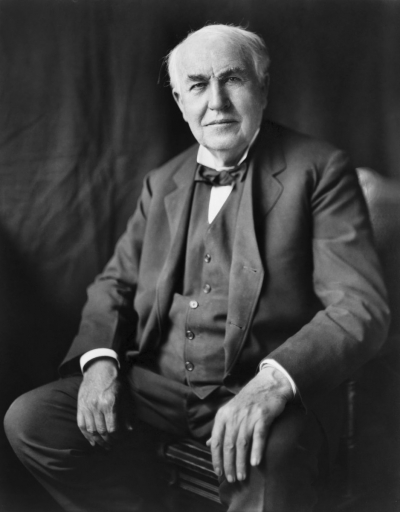The Kinetoscope is an early motion-picture exhibition device. The Kinetoscope was designed for films to be viewed by one individual at a time through a peephole viewer window at the top of the device. The Kinetoscope was not a movie projector, but it introduced the basic approach that would become the standard for all cinematic projection before the advent of video. It created the illusion of movement by conveying a strip of perforated film bearing sequential images over a light source with a high-speed shutter. A process using roll film was first described in a patent application submitted in France and the U.S. by French inventor Louis Le Prince. The concept was also used by U.S. inventor Thomas Edison in 1889, and subsequently developed by his employee William Kennedy Laurie Dickson between 1889 and 1892. Dickson and his team at the Edison lab also devised the Kinetograph, an innovative motion picture camera with rapid intermittent, or stop-and-go, film movement, to photograph movies for in-house experiments and, eventually, commercial Kinetoscope presentations.
A prototype for the Kinetoscope was shown to a convention of the National Federation of Women's Clubs on May 20, 1891. The first public demonstration of the Kinetoscope was held at the Brooklyn Institute of Arts and Sciences on May 9, 1893. Instrumental to the birth of American movie culture, the Kinetoscope also had a major impact in Europe; its influence abroad was magnified by Edison's decision not to seek international patents on the device, facilitating numerous imitations of and improvements on the technology. In 1895, Edison introduced the Kinetophone, which joined the Kinetoscope with a cylinder phonograph. Film projection, which Edison initially disdained as financially nonviable, soon superseded the Kinetoscope's individual exhibition model. Many of the projection systems developed by Edison's firm in later years would use the Kinetoscope name.
Thomas Alva Edison (February 11, 1847 – October 18, 1931) was an American inventor and businessman. He developed many devices in fields such as electric power generation, mass communication, sound recording, and motion pictures. These inventions, which include the phonograph, the motion picture camera, and early versions of the electric light bulb, have had a widespread impact on the modern industrialized world. He was one of the first inventors to apply the principles of organized science and teamwork to the process of invention, working with many researchers and employees. He established the first industrial research laboratory.Edison was raised in the American Midwest; early in his career, he worked as a telegraph operator, which inspired some of his earliest inventions. In 1876, he established his first laboratory facility in Menlo Park, New Jersey, where many of his early inventions were developed. He later established a botanical laboratory in Fort Myers, Florida, in collaboration with businessmen Henry Ford and Harvey S. Firestone, and a laboratory in West Orange, New Jersey, that featured the world's first film studio, the Black Maria. He was a prolific inventor, holding 1,093 US patents in his name, as well as patents in other countries. Edison married twice and fathered six children. He died in 1931 of complications of diabetes.

1897Aug, 31
Thomas Edison patents the Kinetoscope, the first movie projector.
Choose Another Date
Events on 1897
- 22Jun
Chapekar brothers
British colonial officers Charles Walter Rand and Lt. Charles Egerton Ayerst are assassinated in Pune, Maharashtra, India by the Chapekar brothers and Mahadeo Vinayak Ranade, who are later caught and hanged. - 26Jul
Siege of Malakand
Anglo-Afghan War: The Pashtun fakir Saidullah leads an army of more than 10,000 to begin a siege of the British garrison in the Malakand Agency of the North West Frontier Province of India. - 2Aug
Siege of Malakand
Anglo-Afghan War: The Siege of Malakand ends when a relief column is able to reach the British garrison in the Malakand states. - 31Aug
Kinetoscope
Thomas Edison patents the Kinetoscope, the first movie projector. - 12Sep
Battle of Saragarhi
Tirah Campaign: Battle of Saragarhi.

 English
English  español
español  français
français  português
português  русский
русский  العربية
العربية  简体中文
简体中文 